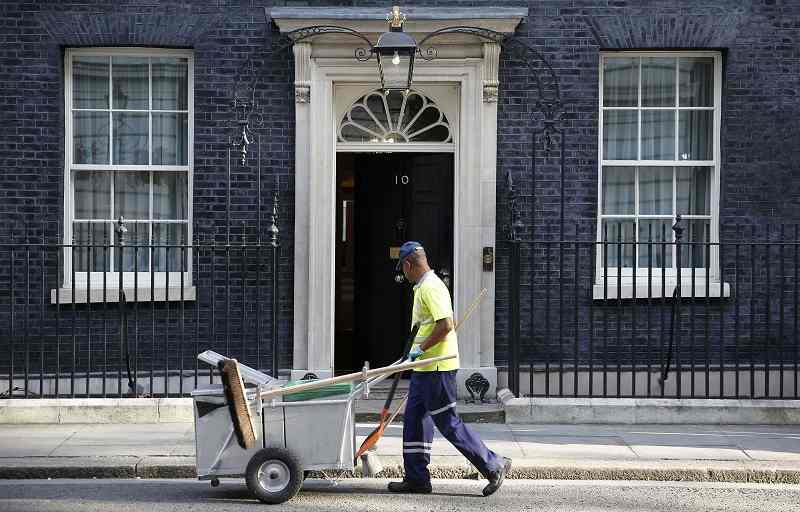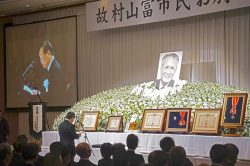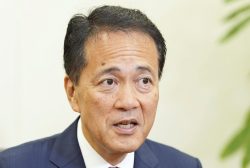
A street cleaner passes 10 Downing Street in London, Britain September 8, 2016.
16:27 JST, October 24, 2022
British Prime Minister Liz Truss announced her resignation in London last week, ending the shortest-lived prime ministership (45 days) in British history. Truss’s tenure appeared to be doomed shortly after she announced her tax plan, leading to an uproar and a rapid fall in Conservative support in public opinion polls. In her resignation speech, Truss promised the public a new prime minister in one week’s time. If this actually happens, it will be an astonishingly fast turnaround, unprecedented in modern history. But the Tories need to move fast if they want to avoid a general election.
Whoever is selected will be the Conservatives’ fifth prime minister in under seven years. Does this mean that the party is in an existential crisis? Alternatively, is the party just brutally efficient at responding when a leader loses public confidence?
– Members can play an important role in choosing party leaders
In Britain, each party sets its own rules for how it selects a leader. With both the Labour Party and the Liberal Democrats, dues-paying party members choose among a list of candidates through a rank-order ballot. The candidate receiving the fewest votes is eliminated, and their votes are reallocated to their voters’ second choices. The process, also called single transferrable vote, is repeated until a single candidate wins a majority. This means that ordinary party members (members of the public who pay the party membership fee) are the key deciders.
The Conservatives do things differently. Instead of immediately handing power over to members, they run a series of ballots (held at different times, typically over the period of a week), which are open only to the party’s members of Parliament (MPs). MPs vote for their leader using a secret ballot. In each round the candidate with the lowest vote share is knocked out.
It is only after the field is narrowed to two candidates that party members get a say. Typically, over approximately two months, the two candidates debate and hold local meetings. This is followed by a mail-in vote open to all Conservative members. The winner becomes the party leader. If the Conservatives control the government, as they do currently, the victor is immediately sworn in as prime minister.
– There will be at most three candidates
Conservative backbenchers – MPs who don’t hold any government office – play a key role in deciding the rules and procedures for the leadership election, through the 1922 Committee. The committee formally calls and sets the timeline for the next leadership election and decides the minimum number of nominations a candidate must receive to make it on the ballot in the first place. It also sets a minimum threshold of votes to advance to the next round, after the first ballot is sent to MPs. This is especially important when there are many candidates running to become leader.
In the election to replace Boris Johnson, the 1922 Committee set a high bar. It required each contender to secure the support of least 20 MPs to compete. In previous elections, the committee set the number as low as two. On Thursday, Graham Brady, chair of the 1922 Committee, announced that candidates needed the exclusive support of 100 MPs to run.
This has big consequences. There are 357 Tory MPs serving in Parliament. That means that at most three candidates could run for the leadership. Even getting three candidates over the threshold would prove difficult. The party is divided, but it isn’t split across three equally-sized cohesive groups.
Economic moderates have started to coalesce around Rishi Sunak, the runner-up in the last leadership election and former chancellor of the exchequer who played a key role in ousting Johnson. As of Sunday afternoon, 147 MPs had gone public supporting his candidacy – closing in on limiting the field to two candidates at most. Tories are also considering Penny Mordaunt, the lesser-known Conservative leader in the House of Commons. Others wanted Johnson, the controversial former prime minister who resigned in July. He claimed he had the support of over 102 MPs but dropped out of the race Sunday.
Only candidates with the required signatures by Monday afternoon can run. If only a single candidate obtains the minimum 100 signatures, they will automatically be elected party leader and hence prime minister. The race is on.
If more than one candidate receives 100 signatures, ordinary party members will perhaps have a chance to vote on the two leading candidates. The tight timeline means that the 1922 Committee has opted for a first-ever online election among members, promising to do its best to reach all members, many of whom are elderly.
The committee has also floated the idea, however, that the candidate with the least support among MPs should stand down, avoiding a leadership election among members. This is a risky move – the less popular candidate may refuse to stand down, and there isn’t much time to put pressure on them.
– MPs don’t want to give ordinary members a say
Tories are promising a swift decision, claiming they want the government to keep running smoothly. But they also need to avoid a protracted leadership race that would show how divided the party is. If they fail to act quickly and unite behind the next leader, Labour’s call for general elections may prevail. Conservatives desperately want to avoid this. They are seriously behind in the polls.
There is another reason. Many Conservative MPs want to avoid giving their members a say. Ordinary members chose Truss, but MPs would almost certainly have preferred Sunak. Members tend to be more extreme in their opinions than their party’s representatives – especially in parties that give them a say. An anonymous ally of former Conservative Prime Minister David Cameron made headlines years ago by describing Tory members as “mad, swivel-eyed loons.” That’s why most Conservative MPs hope the 1922 Committee can use the rules to circumvent party members and win the next election.
"News Services" POPULAR ARTICLE
-

American Playwright Jeremy O. Harris Arrested in Japan on Alleged Drug Smuggling
-

Japan’s Nikkei Stock Average as JGB Yields, Yen Rise on Rate-Hike Bets
-

Japan’s Nikkei Stock Average Licks Wounds after Selloff Sparked by BOJ Hike Bets (UPDATE 1)
-

Japan’s Nikkei Stock Average Buoyed by Stable Yen; SoftBank’s Slide Caps Gains (UPDATE 1)
-

Japanese Bond Yields Zoom, Stocks Slide as Rate Hike Looms
JN ACCESS RANKING
-

Keidanren Chairman Yoshinobu Tsutsui Visits Kashiwazaki-Kariwa Nuclear Power Plant; Inspects New Emergency Safety System
-

Imports of Rare Earths from China Facing Delays, May Be Caused by Deterioration of Japan-China Relations
-

University of Tokyo Professor Discusses Japanese Economic Security in Interview Ahead of Forum
-

Tokyo Economic Security Forum to Hold Inaugural Meeting Amid Tense Global Environment
-

Japan Pulls out of Vietnam Nuclear Project, Complicating Hanoi’s Power Plans





















